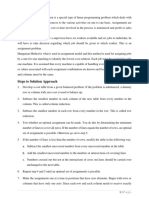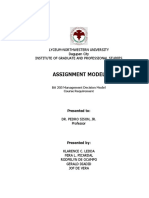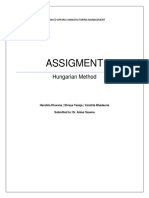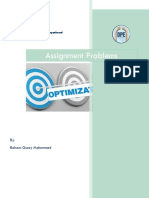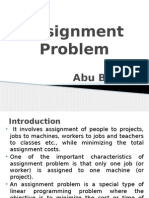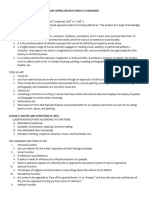0 ratings0% found this document useful (0 votes)
55 views22 pagesChapter 06 Assignment Model
The document discusses the Assignment Model and the Hungarian Method, an algorithm for solving assignment problems by minimizing costs or maximizing profits. It outlines the steps involved in applying the Hungarian Method, including creating opportunity cost tables and determining optimal assignments through systematic reductions. The document also provides various applications of the assignment model in real-world scenarios, such as assigning workers to jobs and machines to tasks.
Uploaded by
fernandezmaekyla1330Copyright
© © All Rights Reserved
We take content rights seriously. If you suspect this is your content, claim it here.
Available Formats
Download as PDF or read online on Scribd
0 ratings0% found this document useful (0 votes)
55 views22 pagesChapter 06 Assignment Model
The document discusses the Assignment Model and the Hungarian Method, an algorithm for solving assignment problems by minimizing costs or maximizing profits. It outlines the steps involved in applying the Hungarian Method, including creating opportunity cost tables and determining optimal assignments through systematic reductions. The document also provides various applications of the assignment model in real-world scenarios, such as assigning workers to jobs and machines to tasks.
Uploaded by
fernandezmaekyla1330Copyright
© © All Rights Reserved
We take content rights seriously. If you suspect this is your content, claim it here.
Available Formats
Download as PDF or read online on Scribd
You are on page 1/ 22
‘An Assignment Model is a probl
costs/profits in such a vray thay at Sequites Pairing two sets of items given a set of
pa ved. It was developed ang ornat, tne total cost/profit of the pairings is minimized or
pe ician in 1955, Ped and published by Harold Kuhn (1925-2014) who was an American
ae ‘ho gave the name "Hungarian method” because the algorithm was
iangelY ean ae ee of two Hungarians mathematicians: Dénes K6nig (1884-1944)
cH eeeticcin| 8 mathematician and Jend Egervary (1891-1958) was a Hungarian
Hungarian Method ox Flood’s Technique is an algorithm used to determine an optimal
solution to an assignment problem. The method is named after a Hungarian mathematician, :
pénes Kénig. He proved a theorem required of the development of Hungarian method. The
Hungarian method yields optimal solutions to the assignment model. The method is based on a
zathematically proven algorithm for determining the optimal solution.
‘The Hungarian method is based on the concept of opportunity losses. This is related on the
opportunity losses in the Vogels’ Approximation Method of the transportation problem. In the
assignment model, the optimal solution gives zero opportunity losses. Any other solution with a
higher cost gives an opportunity loss that is equivalent to its increase in cost over the minimum.
cost resulted in the optimal solution. The basic idea in this method is to avoid opportunity losses.
The assignment problem is a special case of transportation problem in which the objective is
to assign a number of origins to the equal number of destinations at the minimum cost (or
maximum profit). It involves assignment of people.to projects, jobs to machines, workers to jobs
and teachers to classes etc., while minimizing the total assignment costs (or maximizing the total
assignment profit). One of the important characteristics of assignment problem is that only one
jab (or worker) is assigned to one machine (or project). Hence, the number of sources are equal
the number of destinations and each requirement and capacity value is exactly one unit.
A. Some Applications of Assignment Model
Though assignment problem finds applicability in various diverse business situations, such
2 (a) in assigning machines to factory orders; (b) in assigning sales/marketing people to sales
teritories; (c) in assigning contracts to bidders by systematic bid-evaluation; (d) in assigning
teachers to classes; (e) in assigning accountants to accounts of the clients; and much more.
There are simple steps to follow for the execution of the Hungarian Method as shown below:
« Steps in Solving Assignment Model using Hungarian Method |
1 Determine the opportunity cost table. |
a Subtract the lowest entry in each row/column of the given cost table from all entries in|
that row/column for minimization problem. For maximization problem subtract each |
entry in the row/column from the highest entry in each row/column. |
. Subtract the lowest entry in each column/row of the table obtained in part from all |
numbers in that column/row.
2 Determine whether an optimal assignment can be made. The procedure is to draw straight |
lines (vertically and horizontally), using the least number of lines possible. (This can be |
by covering first the row/column with the most number of imal |
Santer 6; Assignment Model Page 217
y
assignment can be made when the number of lines equals the number of rows/columy.
the number of lines drawn is fewer than the number of rows/columns, an Pty
assignment cannot be made and the problem is not solved.
3. Revise the total opportunity-cost table.
a. Select the smallest value of the uncovered line row/column and subtract this Dungy
from all numbers not covered by a straight line.
b. Add this same number to the numbers lying at the intersection of any two lines.
©. Copy the entries covered by a single line, then return to step 2._
Let us consider the example below to illustrate the solution of an assignment mod,
minimization problem.
Example: A plant has 4 operators to be assigned to four machines. The time (in minutes) requiy
by each operator to produce a product on each machine is shown below.
Machine
Operator . ec 5
1 n_| 2 | 10 9
2 io | 5 7
3 n | “4 | 2 | 13
4 9 5 | 8 i
Determine the optimal operator-machine assignment and compute for the total minimum time.
Solution:
In order to solve an assignment model it is necessary to follow the following steps. We ma
apply a row reduction first or even start with a column reduction. In this particular example
will apply a row reduction before a column reduction.
Step 7: Identify the lowest value in each row and subtract it in each row from all va!
appearing in that row. This will ensure a zero entry in each row of the tableau. We hat
identified lowest values in each row: for the first row is 9, second row is 5, and third 1
is 11, and fourth row is 8.
Tableau 1
Machine Row
Operator a B Cc D Reducer
1 Et 12 10 9 9
2 8 10 5 7 &
3 n |. 12 13 n
L 4 9 15 8 il 8
We can now subtract each of the lowest values of each row to every entries of each ™
as shown below.
Page 218
Chapter 6: Assignment Mo! |
asignment TABLEAU With ROW Reductions
Tableau?
Operator |}
ml
nfo fe fr |>
w|r|rlolo}
eo fro
g,Select the minimum entry in each column and subtract it from every entry in that column.
We have identified lowest entries
column is 3, and third column is 0,
the lowest values of
in each column: for the first column is 0, second
and fourth column is 0. We can now subtract each of
each column to every entries of each column as shown below.
tte Assignment Tableau with Column Reductions
wien - Tableau 3
Machine hine
Operator Operator Machin
A B. c D A[s|[c {op
eat 1 2 [0]|1 0
[2 > 2 3 [2 [0 2
3 3 0 0 1 2
L4 4 1 [4 0 3
Column
Reducer
6p Determine if four unique assignments exist in Tableau 3 by drawing the minimum
number of horizontal or vertical lines necessary to cross out all zeros through the rows
and columns of the tableau. (This can be done covering first the row or column having
the most number of zero entries.)
The Opportunity Cost Tableau with the Line Test
Tableau 3 :
| Operator A Machin D
2 3 2 2
4 1 4 3
The three lines indicate that there are only three unique assignments, whereas four are
"equired for an optimal solution since it is a 4 x 4 matrix.
ter Gs Acs ——
6: Assignment Model Page 219
Step 4 Identify the minimum value, which is 1.
Tableau 3
Operator | — Mocs D |
F 3 2 2 |
4 i 4 [3 |
8tep 5: Subtract 1 from all values in Tableau 3 that is not crossed out. Then add 1 to cells wig)
intersecting lines intersect, and copy the rest of the values in the previous tablea)
covered by a single line.
Tableau 4 Tableau 4
: Machine
Machine
Operator a 5 a 5 Operaten [a Bc].
1 2 0 +1 0 1 2 0 210
2 3-1 2-1 0 2-1 |> 2 2 1 0 1
3 0 0 1+1 2 3 0 0 2 [2
4 1-1 4-1 0 3-1 4 0 3 0 2
: Apply the line test again to determine if an optimal solution already exists.
:
The Second Iteration: The Opportunity Cost Tableau with the Line Test
Tableau 4
Operator
fachine
A S D
No matter how the lines are drawn, it will cover all zero entries using the least number!
lines. Four lines are required to cross out all the zero entries. This indicates that the fou"
unique assignments can be made and that an optimal solution has been reached.
&tep 7: Identify the rows with zero entries in their respective columns,
Operator [ Machine | Order of Assignment [Operator | Machine
1 B,D Fourth > 1 D
2 Cc First > 2 c
3 AB Third > 3 B
4 AC Second > 4 A
~»
Notice that row 2 has only 1 zero entry and the rest have two zero entries. In general We
will select the least zero entry forthe first allocation. Then, allocate the rest of the rows t©
complete the assignment, The first assignment is to assign Operator 2 to Machine C; the
second is to assign Operator 4 to Machine A; the third is to assign Operator 3 to Machine
B; and lastly to assign Operator 1 to Machine D.
up % Make the assignments from the last tableau,
[Operator | Machine | Time (in minutes)
1 D 9
2 c 5
3 B 4
4 A 9
L Total 37
The assignment distribution shown resulted to the most efficient distribution of job
assignments of operators to machines
| # Enrichment Exercise 6.2
‘A municipal government wants to improve the efficiency of the local court system. It has}
“collected data on the average length of time a particular judge requires to handle each type of|
case. Given the composition of the types of cases scheduled on each docket (the official!
| schedule of proceedings in lawsuits pending in a court of law), the times shown in the table|
| rere estimated for each judge to process each different docket. Determine the assignment of|
| judges to dockets to minimize the time required to complete all dockets.
| Cn ee] | |
| Judge x BTC D | | i
| T B [7 | a @ |
2 20 | 15 | 15 15 |
FZ is [a | ie | | 25 .
copy es a] 7 19 ts
5 15 18 20 13 \
There is a slight difference between the solution set of a minimization problem and |
‘naximization problem, the difference is selecting the highest value in each row or column on the !
ital tableau. The rest of the procedure is the same with the Hungarian Method in minimization
Problem. This section illustrates the solution of an assignment model in maximization problem. \
Sample: MSS Car Rental Agency plans to purchase five new automobiles to replace five older, |
Whicles, The older vehicles ‘are to be sold at auction. The agency has solicited from five
"dividuals, each of whom wishes to buy only one vehicle but has agreed to make a sealed bid on
‘ch of the five. The bids are as follows in terms of (P10,000): ; i,
— 4
LL Automobile =
[Toyota | Mitsubishi | Ford Nise tz ia
[12 20 10 2
[10 13, in 9 “
5 6 “10 7 B
9 7 10 9
10 4 12 10 6
The agency wishes to determine which bid to accept from each of the five a 50 that each y
them can buy one vehicle while the total of the five accepted bids is a maximum.
Solution:
Before we start the solution set, we will replace the names of the sutcmmobiles by A,B, So,
and E for Toyota, Mitsubishi, Ford, Nissan, and Mazda, respectively for computation
convenience on the application of the Hungarian method.
Automobile
Buyer AB ci[p/E
1 12_| 20 | 10 | 8 Zz
2 10 13 1 9 14
3 5 6 | wl 7 5
4 9 7 | wl[o [un
5 io | 14 | 12 | 10 | 6
In order to solve an assignment model itis necessary to follow the following steps.
‘tp 7: Identity the highest value in each row. Then, subtract each row value from the highs
values, This will ensure a zero entry in each row of the tableau,
Tableau
Buyer Automobile Row
Als C [TD] E | Reducer
1 122 | 20 | 10 8 7 20
2 {10 [3 [at [9 a4 4 -
4 9{7 09s Tn 1
5_| 10 | 14 | 12 [a0 1-6 14
The Assignment Tableau with Row Reductions
Tableau 2 Tableau:
= Automobile i
. : = . ; Buyer | —__— Automobile ;
A_[ 20-12 | 20-20 [20-10 | 30-8 | 30-7 1 8 ji Te 3
2 {14-10 [14-13 [44-17 | taco i414) | ste o
3_| 10-5 | 10-6 [20-70 | qo=7 10-5 3° [sla +t 3
4 {uno [ -7 [at-10 as ary 4 [2Ta rh wet
5_| 14-10 [14-14 [aa=19 [tant 14-6 | 5 4 To > i 8
4
Page 222
Chapter 6: Assignment Model
ee
2, Select the minimum en
tr
or Y in each column and subtract it from every entry in that
column.
Tableau 3 y
Buyer a Automobile
1 8 B ¢ D E
2 a jo | 12 | 13
4p t's 5 | 0
p35 | 4 | 0 3 [5
: 2 A 2 0
- eee ome 2 4 8
‘Column 2
a 0 2 0
The Assignment Tableau with Column Reductions
Tableau 3 Tableau.
fe ‘Automobile _ Automobile
A B ce D yer [A TB [c|[DIE
1 8-2 | 0-0 | 10-0 | 12-2 | 13-0 1 6 0 10 10 13
2 4-2 1-0 3-0 5-2 o-0 |> 2 2 1 3 3 oO
3 5-2 | 4-0 0-0 3-2 5-0 3 3 4 0 1 5
4 2-2 | 4-0 1-0 2-2 0-0 4 0 4 z o 0
5 4-2 | 0-0 2-0 4-2 8-0 5 2 o 2 2 8
Susp 3: Determine if five uniqui
number of horizontal or vertical lines necessary to cross
and columns of the
The Opportunity Profit Tableau
Tableau 3
tableau.
Buyer
2
‘The four lines indi
required for an opti
8% ¢, Identify the minimum value,
icate that t
mal solution.
which is 1-
Chapter 6: Assignment Model
with the Line Test
here are only four unique assi
1e assignments exists in Tableau 3 by drawing the minimum
out all zeros through the rows
ignments, whereas five are
Page 223
wa wa
Tableau 3
‘Autofhobile
Buyer | a .
1 6 10
2 [2 3
3 3 1
5 [2 2
Step 6: Subtract 1 from all values in Tableau 3 that is not crossed out. Then add 1 to cells wig
intersecting lines, and copy the rest of the values in Tableau 3 covered by a single line,
Tableau 4 Tableau 4
i ‘Automobile ]
Buyer [“a_[ 8 eT E Buyer "a |B] c[ODTE
1 [6-1] 0 | 10 13 1 5 | o0]0]9 |
= 2-1 1 3 0 = 2 1 1 3 2 Oo
3_|3-1, 4 | 0 5 3 2,4 ]/ofo]s)
4 0 [4+ifi+i] 0 [ori 4 o}s)]2fo]1
5 |2-1| 0 | 2 [2-1] 8 5 1/o[2lils
Step 6: Apply the line test again to determine if an optimal solution already exists.
‘The Second Iteration: The Opportunity Profit Tableau with the Line Test
Tableau 4
Buyer Automobile
A c | D
1 5 1o_| 9
2: )1 3 2
5 il 2 1
There are only four lines which indicate only four unique assignments in Tableau 4
whereas we need five lines for an optimal solution. Thus, we will return to step 4.
Otep 4: Identify the minimum value, which is 1.
Tableau 4
: Buyer Automobile
A c
1 5 10 9
2 i 3_[ 2
5 1 2 1
Se
Page 224
, Subtract 1 from all valu
OF otersecting lines, and = es 4 that is not crossed out. Then add 1 to cells with
'Y the rest of the values in Tableau 4 covered by a single line,
soneae
‘Automobile
pye [a Tey c To Buyer ‘Automobile
71 5-1 [0 [ao-i pe x ALBlcl]DIE
1-1 1
ia ppt ea Po = 4 ots ts
a o [5e1| 2 4 54+i 3 2[s5 [olfol|e
ks f1-1[ 0° [2-17 ug 4 o |6 |2)]o|2
U—— =1| 8 5 ofol[i{fol|e
6: Apply the line test agai ined
isp & Apply again to determine if an optimal solution already exists.
Thi ion
The Third Iteration: The Opportunity Profit Tableau with the Line Test
Tableaa 5
Automobile
Buyer 7m
A clTDp]eE
Hl 4 9 | 8 [13
We already made use of five lines to cover the zero entries in Tableau 5, thus this
indicates that the optimal solution has been reached.
{xp 7: Identify the rows with zero entries in their respective columns.
Notice that Row 1 has only one zero entry, therefore we will select Row 1 for the first
allocation. Then allocate the rest of the rows to complete the assignment.
[Bayer [Automobile ] Order of Assignment [ Buyer _| Automobile {
1 |B First> [1 B
2 |AE Second>| 2 E
3 |cD Third>| 3 c
4 |AD Fourth>| 4 A
5 |ABD Fifth > |_5 D
Sip & Make the assignments from the last tableau.
Buyer | Automobile | Arhount
1 B—Mitsubishi | 200,000
2 E- Mazda 140,000
3 C-Ford a
4 A-Toyota » 90,
5 D- Nissan 100,000
Total P630,000
‘hapter 6: Assignment Model Page 225
The assignment distribution shown resulted to the most efficient assignments of buy,
to automobiles.
Alternative Optimal Solution:
Buyer | Automobile | Order of Assignment | Buyer _| Automobile
1 |B First> | 1 B
2 |AE Second-+| 2 E
3 |coD Third> | 3 c
4 |A,D Fifth > 4 D,
5 |ABD Fourth > |_5 A
Buyer | Automobile | Amount
1 B-Mitsubishi | P200,000
2 E-Mazda 140,000
3 C-Ford 100,000
4 D-Nissan P 100,000
5___| A-Toyota- P 90,000
Total 630,000
Notice that instead of assigning Buyer 4 to Automobile A and Buyer 5 to Automobile
wwe made some re-assignment from Buyer 4 to Automobile D and Buyer 5 to Automobi
A. Stil it will generate the same amount of P630,000.
Page 226
is section Will Tlusnee eae Probie
lustrate ho
Ww
inimization problem. A du, to deal with unbalanced assignment model particularly a
i my ro
one relationship for an assignment Se column is being added to satisfy the one-to-
, dummy will
To understand it clearly let us see the exampl 7 ae tre eae
imple,
Cab Customer
A | B c D E FE
ut 7 | 5 8 2 [3/6
2 2 1 7 5 3 2
2 4 5 6 2 5 4
4 wo | 6 5 4 [8 3
5 7 | 6 5 5 [4 4
Determine the optimal assignments) that will minimize the total distance traveled.
Solution:
In order to solve an assignment model it is necessary to follow the following steps.
typ 1: Introduce a dummy row to balance the number of rows and columns, since there are six
columns and 5 rows to make it even to six-to-six.
Tableau
Customer
Cab A | B c D E F
1 7 | 5 8 2 [3 6
2 2 1 7 5s | 3 | 2
3 4) 5 6 2 5 | 4
4 wo | 6 5 a S J
3 7 6 5 5 4 4
Dummy [0 | 0 0 0 o Lo
8p 2:Select the minimum entry in each row and subtract it from every entry in that row.
! ‘Customer Row
Cab A Tec [DE] FE | Reducer
T 7 5 8 2 3 6 2
2 7 p1[7{[st32 ;
3 aps fe t2{si4 ; 2
4 w fo |s{4}s 2 4
5 Z o fs {st 0 0
Dummy | o | o | % o 10
Page 227
hapter 6; Assignment Model-
Customer.
o-0 | 0-0 | 0-0 | 0-0
0-0
0-0
Cab
The Assignment Tableau with Row Reductions
2
3
4
Step 3: Select the minimum entry in each column & subtract it from every entry in that colum,
Customer:
0
Cab
Tableau 2
Dummy
0
Column
Reducer
ductions
The Assignment Tableau with Column Re
Tableau 3
Tableaa3
“-s--
Customer
alalo
olefo
< nolo
3 “P| .
=
oJefefeelo j
af T/9/9/ 91 7/5 #
+He[[[4) 2 fe
elefelefafo] » F 18
wf T/TIS/SIS/T] B a
afeymlwlofol 3
§
olelelolelel 2 2
foltTUT19/9] BB
BPlslafefAptls} o
g| €. 8
z elelele| so
Tattoo
gly slaftjo] 2 2
2
elololo] &
0 ilait{t] a. B
ofolals] 2 Bel
28 §
elo] 2D
< a) & 2
ole] < BS
¥
2
8
a HirEPE &
Notice that there 7
Aare only five ines, whereas six are required for an optimal solution.
, Identify the mini
on 5; Identify the minimum value, which is 1
Tableau 3
| cab
{ep 6 Subtract 1 from all
values in Tableau 3 that is not crossed out. Then add 1 to cells with
intersecting lines, a
ind copy the rest of the values in Tableau 3 covered by a single line.
‘anioan 4 Tableau
low ‘Customer Cm
\*Ta Te [clp]TelFr STayetc [pele
fiis-1[3 [e-a[0 [1 [4 tlaf3{sfoli1|4
{2 fi-i1] 0 [o-i] 4 2 1 2tovto{s {a {2a
[3 [2-1] 3 [4-1] 0 3 2|>[3 Tilt3aft3sfofs {2
[4 [o-1[ 3 [2-1] 7 5 o 4tol{3fififtsto
5 [3-1[ 2 [1-1] 7 0 o s [2{2fofiltoto |
p] o [o+r] o [o+1 [o+i [o+r Di] Rosfeaaftos{ apa ae
{%p 7: Apply the line test again to determine if an optimal solution already exists.
The Second Iteration: The Opportunity Profit Tableau with the Line Test
Tableau
Cust
cab A B ic E
1 4 3 5 1 }
3 1 3 3 3
4 3 1 5
There are only five lines which indicate five unique assignments in Tableau 4, whereas
we need six for an optimal solution. Thus, we will return to step 5.
8496: Identify the minimum value, which is 1-
Tableau 4
Cust
b
cl A B c B
1 4 3 5 1
3 i 3 e
4 6 3 1 .
Step 6: Subtract 1 from all values in Tableau 4 that is not crossed out. Then aa Lito cals
intersecting lines, and copy the rest of the values in Tableau 4 covered Py a single ling
Tableau 5 - Tableau5
Cistimner b ‘Customer
@CaTs Te] p Let Cb TA TB. CI]DIEI?
1_| 4-1] 3-1|5-1] o [1-1] 4 1 3 [2] 4 0 olg
2 0 0 5 [4+1] 2 [1+1]/>|2 [o ]o| 5 5 [2 [7
3_[1-1]3-1 [3-17 0 10) m2. 3 ,o{2]/2][o]{212
4 |6-1/3-1/i-1| 1 -1/ 0 4{/5{[2]o0]1]4[o
5 | 2 [2 [oo [asi] o [ort 5 }2{2]/o0 [201
D o 1 oO 1+1 1 1+1 D 0 1 0 2 1 2
Step 7: Apply the line test again to determine if an optimal solution already exists.
The Third Iteration: The Opportunity Profit Tableau with the Line Test
Tableau 5
ear stom:
Bi F
1 2 4
3 2 2
2 1
Dummy 1 I
No matter how the lines are drawn in Tableau 5, we will need at least six lines to o°8
out all the zero entries. This indicates that the six uni 5 i
that an optimal solution has been reached, ‘Que assignments can be made
rep & Identify the rows with zero entries in their respective columne
Then allocate the rest of the rows to complete the assignment. :
. ignment.
Cab [Customer] Order of Assignment os
1 DE Third —» ' Customer
2 |AB Teele i DI
3. |AD Fourth c e
: g ; Second -> 4 x
Dumay | A.C Sixth 5 bs
Fith > |_Dummy gE
Chapter 6: Assignment oH
that all rows have 2 ze,
oneness 70 entries but we can only allocat Column B. Then
asocate the ain “ssignments using elimination method. See Row 2
gop * Make the assignments from the last tableau.
Cab Customer | Di ti i "
oP See istance (in km)
2 B ;
3 A 4
4 Ff 3
5 E 4
Dummy Cc 0
Total “4
Alternative Optimal Solution:
Cab Customer. Order of Assignment Cab Customer
1 DE Third + 1 E
2 AB . First > 2 B
3 AD Fourth > 3 D
4 GF Second -> 4 F
5 GE Fifth > 5 c
Dummy | A.C Sixth > |_Dummy A
Cab_| Customer | Distance (in km)
1 E 3
2 B 1
3 D 2
4 F 3
5 c 5
Dummy, A o
Total 14
| 7 enrichment Exercise 64 «|
The National Bureau of Investigation has five NBI squad-agents available for assignment 9}
six cases, The NBI Chief wishes to assign the squads so that the total time to conclude the|
‘ases is minimized. The average number of days, based on past performance, for each squad.
tocomplete the case is as follows:
| ‘Case
Squad }—z B Cc D E | F
j i) | 7 | a | i pe
5 | | 36 | 10 | 28 | 12
| | ie) a7 | 10 | [3] 30
| 9 9 | 20 | 26 | 0
5 33) 16 [a8 [8 | is [ai
“pte 6: Assignment Model me
ye
| be effective in certain types of cases,
_ by using the Hungarian method. _
In this section it will illustrate how to deal with w
maximization problem. A dummy row or dui
one relationship for an assignment model. The
Example: A high school department head ha
levels. All of the teachers have taught the diffe
they may be almost u
mmy column is <
dummy will have zero entries.
list and, as noted, whereas one squad may
balanced assignment model ;
being added to satisfy the one
‘seless in others. Solve the problem,
s five teachers to be assigned to four different ye
rent year levels in the past & have been evaluate
by the students, The rating for each teacher for each year level is given in the following table.
Year Level
Teacher |~First_| Second | Third’ | Fourth
1 80 75 90 85
2 95 90 90 97
3 85 95 88 91
4 93 2 80 84
5 91 92 93. 88
The department head wants to know the optimal assignment of teachers to year levels that wil
| maximize the overall average student evaluation rating. The teacher who is not assigned to tead
| _ will be assigned as secretary. Solve this problem using the assignment method.
Solution:
In order to solve an assignment model it is necessary to follow the following steps. But befot
we start the Hungarian method we will represent the year levels by A, B, C, ahd D for Fi
Second, Third, and Fourth, respectively.
Step 7: Introduce a dummy column to balance the number of rows and columns to 5 x 5 matti
Tableau’
Teacher a 5 Year Level
£ D | Dumm
1 80 B 90 5 0 ny |
2 95 90 90 97 a
3 85 9% 88. o a
4 93, Bt 80 aa 7 |
5 a1 92 3 a 5
|
Step 2: Identify the highest value in each row. Then, subtract each row value from the hi
values. This will ensure a zero entry in each row of the tableau.
Page 232
i
|
i
4
Chapter 6: Assignment Model
Teacher |< Yearbevd ———] gy
7 B | cTp Dummy | Reducer
80 [75 [90 asp °0
z 23_| 90 | 90 [97 0 7
ee) °
5 [1 [92 [93s t—> 3
spe Assignment Tableau with Row Reductions
yonan Year Level 2
f vl YearLevel
teachet [A B c D_| Dummy Teacher [AT Bc | D | Dummy
fa 90-80 | 90-75 | 90-90 | 90-35 90-0 1 io} is |o|s5 wn
| oA% a oo 7-97 | 97-0 . 2 7 710
mc =%5 | 95-88 [95-91 | 95-0] = [3 [oto [7 [4] 95
[a] 93-93 [93-91 | 93-80 | 99-84 | 93-0 « fot2}ste
iB 33-91 | 93-92 | 93-93 | 93-88 | 93-0 s [2}ifo|s]
{tp & Select the minimum entry in each column & subtract it from every entry in that column.
Tableau 2
Year Level
Teacher [A [8 [| c | D [Dummy
1 10 15 oO 5 90
2 2 7 7 } 97
3 10 oO 7 4 95
4 o 2 13 9 93
5 2/1[o0l[s| 9% ‘
Column «Og ee
Reducer
Tega Talon 3
Year Level Year Level
Inte |p eB Teacher AT BC | D | Damm
1 fi0-0 | 15-0 | 0-0 | 5-0 | 90-9 1 wo {is [o|5 0
2 [2-0 [7-0 | 7-0 [0-0 | 7-9 2 [2|7|7]0o 7
3 Tio 0-0 | 7-0 [4-0] 5-0 |>[ 3 [wlot7|4 3
4 [0-0 | 2-0 | 13-0 | 9-0 | 93-90 4 lol2|nlo| 3
5 2-0 | 1-0 | 0-0 | 5-0 | 3-9 5 2{1ijo0j5 5
q
"oper 6: Assignment Model ; Page 233
Step 4 Apply the line test for optimality.
‘The Opportunity Value Tableau with the Line Test
Tableau 3
Yel Level
Teacher } <—— Dammy |
[2 2 7 7
ae
ee
Cos 2 1 3
No matter how the lines are drawn in Tableau 3, at least five lines are required to
out all the zero entries. This indicates that the five unique assignments can be made
that an optimal solution has been reached.
Step 5: Identify the rows with zero entries in their respective columns. Then, allocate the rest
the rows to complete the assignment.
Teacher | Year Level_] Order of Assignment [ Teacher | Year Level
1 |C Dummy Fifth > 1 Dummy
2 D First > 2 D
3 B Second + 3 B
4 iA Third > 4 A
5 [c Fourth>| 5 c
Step 8: Make the assignments from the last tableau,
{ Teacher | Year Level Rating |
| 1 Dummy 0
2 |D-Fouth v7 Thus, Teacher 1 will be
3 B~Second 95 assigned as secretary.
| 4 A- First 93
5__|C~-Third 93
{ Total 378
| The Human Resource Department has recentl i
ly tested seven applicants for six jobs that aff
| available at the AUS Call Center Agency. Each job has primary skill, and AUSs cyectve is
| se Sh applicants whose aptitude test scores will maximize total performance. Only oM|
| (Worker can be assigned to only one job. The aptitude test i Determifé
Peretti deplored pt st scores are listed below. Dete
Page 234
| Chapter 6; Assignment Mod!
This section pastes how to solve degenerate case of assignment model. Degeneracy occurs
if one or more destination has some restrictions in their assignment or destination. The next
example will give light to the application of degeneracy in assignment model.
Example: The WSS pharmaceutical firm has four salespersons, the firm wants to assign to four
regions. Given their various previous contracts, the salespersons are able to cover the regions in
different amounts of time. The amount of time (in days) required by each salesperson to cover
each city is shown below, except for Salesperson 1 who refuse to be assigned in Region B with no
time table. Which salesperson should be assigned to each region in order to minimize total time?
Identify the total assignment and compute for total minimum time.
Solution:
typ 1: Select the minimum entry in each row and subtract it from every entry in that row.
rion
Seren awa a ¢ | D
r 7 [| M | 64 | 60
2 54 58 55 52
3 | «4 | 58 | 56
4 70 67 62 60
Note that M is not used in any reduction, nor is any value added to it or subtracted from it
during the course of the analysis.
Region
Salesperson tac Tey
1 7o_| M | 64 | 80
2 54 58 55 52.
3 68 64 58
a 70 | 67 | 62 | 60
“hapter 6: Assignment Model
Page 235
‘The Assignment Tableau with Row Reductions
Tableau Tableau 2
: Year Level Salesperson Year Level
3 |e B Cc D Als cys
1 70-64 64-64 | 80-64 1 6 | MT] ote
2 54-52 | 58-52 | 55-52 | 52-52 | > 2 216} 375
s) 68-56 | 64-56 | 58-56 | 56-56 3 wi slaty
4 70-60 | 67-60 | 62-60 | 60-60 4 wo] 7 Tat
Step 2: Select the minimum entry in each column é& subtract it from every entry in that Colum,
Tableau 2
Region
Salesperson -— ceo
1 6 [Mo [16
2 2 [6 | 3 0
3 zfs t2tfo
4 wo [7 | 2 0
Column 2 6 0 0
Reducer YY
The Assignment Tableau with Column Reductions
3
Tableau 3
Year Level Year Level
Salesperson person
2 A.B 7) ae ATs Ic »)
1 6-2 | M 0-0 | 16-0 1 4|M|o|
2 2-2 | 6-6 [3-0 | 0-0 | > 2 ojo} 3io
3 12-2 | 8-6 [2-0 | 0-0 3 jo] 2 [2 [0
4 10-2 | 7-6 [2-0 | 0-0 4 8 | 1f{2 {0
Step 3: Apply the line test for optimality,
The Opportunity Value Tableau with the Line Test
Tableau3 .
Salesperson 3
1 4 [™M
3 io [2
4 8 1
Notice that there are only three lines in Tableau 3, whereas four
” are
optimal solution, See?
Page 236
Chapter 6; Assignment Mode
iz entity the minimum value, which is 1
Tableau 3
lesperson. Regio
salespe ia
1 4
ae
3 10
4 8
g Subtract 1 from all values in Tableau 3 that is not crossed out. Then add 1 to cells with
intersecting lines, and copy the rest ofthe values in Tableau 3 covered by a single line-
aueet— 5 Tableau 4
car Level ‘Year Level
person
salespet A B c 5 salesperson |=] cD.
a 4-1 [| M 0 16 i 3. [mM] 0 | 16
2 0 0 3+1 [| o+1 |> 2 o}of4]1
10-1 2-1
js 2 0 3 9{i/2]|0
a Ca es! 2 0 4 71o0[2]0
up: Apply the line test again to determine if an optimal solution already exists.
‘The Second Iteration: The Opportunity Profit Tableau with the Line Test
Tableau 4
Regio
Salesperson | 73
1 3_[M
3 9 1
No matter how the lines are drawn in Tableau 4, we need at least 4 lines to cross out all
the zero entries. This indicates that the 4 unique assignments, thus, an optimal solution i
has been reached.
usp 7: Identify the rows with zero entries in their respective columns.
‘Then allocate the rest of the rows to complete the assignment
Galesperson | Region _| Order of ‘Assignment [Salesperson | Region
1 c First > 1 c
2 AB Fourth > 2 A
3 D Second > 3 D
4 B,D Third > 4 B
ye one zero entries, thus we will start the assignment
Observed that Row 1 and Row 3 ha
emaining assignments using elimination method.
with these rows. Then, allocate the re
Chapter 6: Assignment Model Page 237
Step 8: Make the assignments from the last tableau.
Salesperson | Region | Days
1 c 64
2 A 54
3 D 56
4 B 67.
Total | 241
# Enrichment Exercise 6.6
‘An advertising company is trying to decide which of six account executives to assign to ead
of six major clients. The estimated costs of each assignment for each executive are presented ix
the table, except for Executive 4 and 5 who refuse to be assigned in Account D and ¢
respectively. Use Hungarian method to determine the optimal solution to this problem. State
the value of the objective function.
Clients
ecutive ATT eS | DET FY
T 3 |H| 0) ie | 2m)
| 2 30 12 18 il 16 26
i “330 96 5. | 18 29) 4
| 4 ib [a |) M | im) 2
| 5 7 [9 | M | m@ | 2) 20
[6 2b lB [is [ay 2
Page 238 = ad
You might also like
- Operations Research - Lecture Twelve - Assignment ModelsNo ratings yetOperations Research - Lecture Twelve - Assignment Models7 pages
- New Approach To Solve Assignment Problem Using MATLAB: Dr. Jihane KHODERNo ratings yetNew Approach To Solve Assignment Problem Using MATLAB: Dr. Jihane KHODER13 pages
- Hungarian Method for Assignment ProblemsNo ratings yetHungarian Method for Assignment Problems2 pages
- Assignment Model & Hungarian Method GuideNo ratings yetAssignment Model & Hungarian Method Guide51 pages
- Hungarian Method for Assignment ProblemsNo ratings yetHungarian Method for Assignment Problems17 pages
- Assignment Algorithm (Operations Research) Hungarian Method100% (1)Assignment Algorithm (Operations Research) Hungarian Method14 pages
- Hungarian Algorithm for Assignment ProblemsNo ratings yetHungarian Algorithm for Assignment Problems42 pages
- Describe The Assignment Problem and A Common Method Used To Solve ItNo ratings yetDescribe The Assignment Problem and A Common Method Used To Solve It4 pages
- International Institute of Professional Studies: Presentation On Assignment ProblemNo ratings yetInternational Institute of Professional Studies: Presentation On Assignment Problem13 pages
- Assignment Model: Prepared By: Prof. Irah Dianne NicolasNo ratings yetAssignment Model: Prepared By: Prof. Irah Dianne Nicolas10 pages








